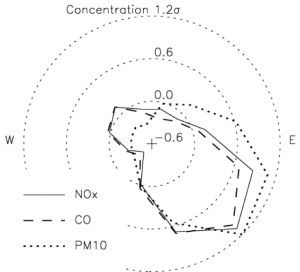This paper was published in Atmospheric Environment back in 2006. It examines the well-known increase concentration of particulate matter in the air over UK cities when the wind blows from the South-East. It is generally assumed that this feature is due to transport from the continental Europe. However, we show that, whilst long-range transport will certainly be responsible for much of the concentration increase, the weather conditions that occur when the wind blows from the South-East also have the effect of increasing the concentration of locally-emitted pollutants.

One of the simplest ways of thinking about how the weather affects the concentration of urban air pollutants is to imagine that pollutants are emitted into a ‘box’ that sits over the city. If the emission rate stays the same, we can still get changes in the pollutant concentration by either changing the rate that the wind blows pollutants through the box, or by changing the height of the box.
We all know what the wind speed changes all the time, so it’s easy to see how the wind can change pollutant concentration, but what determines the height of this imaginary box over a city? Well, the idea of a ‘box model’ comes about because of the properties of the atmosphere close to the Earth’s surface. High up in the Earth’s atmosphere, the air stays relatively unperturbed and travels in a relatively stable way. However, in its lowest levels, contact with the surface makes the air turbulent (the wind becomes gusty). The turbulence keeps the air well-mixed in this so called ‘boundary-layer’. This means that, as an approximation, we can assume that once pollutants are emitted, they are mixed throughout this layer. So, the thinner this layer is, the smaller the ‘box’ and the higher the concentration of pollutants emitted into it.
It so happens that in the UK, when the air blows from the South-East, the average boundary layer height and the average wind speed are both lower (part of the reason that the boundary later is thinner is because the wind speed is lower). Therefore, on average, we would expect pollutants emitted in UK cities to have a higher concentration in the atmosphere when the wind blows from the South-East than from other directions. A similar effect was found at many locations around the world.
